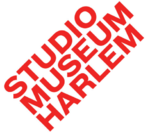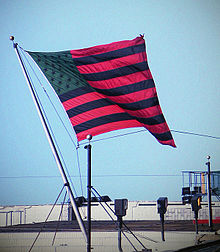Studio Museum in Harlem
 | |
 | |
| Established | 1968 |
|---|---|
| Location | 144 West 125th Street Manhattan, New York City |
| Coordinates | 40°48′30.52″N 73°56′51.12″W / 40.8084778°N 73.9475333°W |
| Director | Thelma Golden |
| Public transit access | Subway: Bus: M7, M60 SBS, M100, M102, Bx15 |
| Website | studiomuseum |
The Studio Museum in Harlem is an art museum that celebrates artists of African descent.[1] The museum is located at 144 West 125th Street between Adam Clayton Powell Jr. Boulevard and Lenox Avenue in the Harlem neighborhood of Manhattan, New York City, United States. Founded in 1968, the museum collects, preserves and interprets art created by African Americans, members of the African diaspora,[2] and artists from the African continent. Its scope includes exhibitions, artists-in-residence programs, educational and public programming, and a permanent collection. The museum building was demolished and replaced in the 2020s; a new building on the site is to open in 2025.
Since opening in a rented loft at Fifth Avenue and 125th Street, the Studio Museum has earned recognition for its role in promoting the works of artists of African descent. The museum's Artist-in-Residence program has supported over one hundred graduates who have gone on to highly regarded careers.[3] A wide variety of educational and public programs include lectures, dialogues, panel discussions and performances, as well as interpretive programs, both on- and off-site, for students and teachers. The exhibitions program has also expanded the scope of art historical literature through the production of scholarly catalogues, brochures, and pamphlets.
History
[edit]
The idea that became the Studio Museum was developed by a diverse group of founders in the belief that the African-American community should include a museum as part of its everyday experience, and to reflect their interests. Opened in 1968, in a rented loft, the Studio Museum in Harlem moved to its present location in 1982,[4] where it focuses on exhibiting works by both emerging and established artists of African descent.
The museum celebrated the opening in September 1968 of its first exhibition, Electronic Reflections II, featuring works by Tom Lloyd, an artist who worked primarily in abstraction to create technology-driven light works.[5]
From 1970 to 1978, Gylbert Coker, the first chief curator of the museum set up the registration system for the SMH art collection which was later housed in The State Office Building. She arranged for the saving and cleaning of the Works Progress Administration Federal Art Project murals in Harlem Hospital that were done by Charles Alston. She curated several major exhibitions, among them, Bob Thompson (which revitalized the recognition of Thompson's art work), Hale Woodruff: 50 years of His Art, and Contemporary African American Photographers.
Originally, the museum focused on workshops and exhibition programs that were designed to give artists a space to practice their craft, create works and show them. This idea led the trustees of the museum to start an Artist-in-Residence program. The proposal for the studio component of the museum was then written by the African-American painter William T. Williams, who believed it was important to have black artists working in the Harlem community, and also exhibiting their work in that community. Williams and sculptor Melvin Edwards physically cleaned up and prepared the former industrial loft space at the museum's original location at 2033 Fifth Avenue (at 125th Street) for conversion into artists studios. The first artist to work in the top floor studio space was printmaker and sculptor Valerie Maynard.[6]
The museum also maintains an education department; in the 1970s, artists Janet Henry and Carrie Mae Weems worked in the Education Department.[7]

In 2001, architects Rogers Marvel Architects designed the building's entry pavilion, exhibition spaces and auditorium, as well as other facilities.[4]
The museum's Artist-in-Residence program celebrated its 40th year in 2010. It has helped to cultivate the art-making practices and careers of more than one hundred artists, and the museum has fostered the careers of numerous museum professionals as well.
Naima Keith, a former associate curator, created several exhibitions during her tenure, including: "Rodney McMillian: Views of Main Street" (2016), "Artists in Residence 2014–2015" (2015), "Charles Gaines: Gridwork 1974–1989" (2014), "Titus Kaphar" (2014), "Glenn Kaino" (2014), "Robert Pruitt" (2013), "The Shadows Took Shape," co-curated with Zoe Whitley (2013), and "Fore," co-curated with Lauren Haynes and Thomas J. Lax (2012).[8][9]
New building at 144 West 125th Street
[edit]In 2015 award-winning architect David Adjaye — whose firm Adjaye Associates designed the Smithsonian Institution's National Museum of African American History and Culture — was commissioned to design a new home for the Studio Museum in Harlem, which will allow the museum to expand its exhibition schedule.[10][11] In 2021, Studio Museum announced that it had raised $210 million for the construction, endowment and operating fund for its new building.[12] By 2023, the museum parted ways with Adjaye in response to the allegations of sexual harassment and misconduct against the architect.[13] As of August 2024[update], the new museum building on 125th Street in Manhattan is still under construction[14][15] and is planned to open in late 2025.[16]
Museum directors
[edit]The museum's first director was Charles Inniss.[17] Directors since that time have been Edward Spriggs, Courtney Callender, Mary Schmidt Campbell, Kinshasha Holman Conwill, Lowery Stokes Sims, and Thelma Golden, its current director.[18] In October 2024, the Ford Foundation gave the museum a $10 million grant to fund an endowment for its director and chief curator positions.[19][20]
Artist-in-Residence program
[edit]Each year, the Studio Museum offers an 11-month studio residency for three local, national, or international emerging artists working in any media. Each artist is granted a free non-living studio space and a stipend. Artists have access to the museum's studios and are expected to work in the studio a minimum of 20 hours per week and participate in open studios and public programs. At the end of the residency, an exhibition of the artists' work is presented in the museum's galleries.[21]
| Artist[22][23] | Year of Residency |
|---|---|
| Mequitta Ahuja | 2009–10 |
| Njideka Akunyili | 2011–12 |
| Sadie Barnette | 2014–15 |
| Kevin Beasley | 2013–14 |
| Sanford Biggers | 1999–2000 |
| Chakaia Booker | 1995–96 |
| Jordan Casteel | 2015–16 |
| June Clark | 1996–97 |
| Gregory Coates | 1996–97 |
| Bethany Collins | 2013–14 |
| Sonia Louise Davis | 2023–24 |
| Louis Delsarte | 1979–80 |
| Abigail DeVille | 2013–14 |
| Lauren Halsey | 2014–15 |
| Allison Janae Hamilton | 2018–19 |
| EJ Hill | 2015–16 |
| Jibade-Khalil Huffman | 2015–16 |
| Texas Isaiah | 2020–21 |
| Steffani Jemison | 2012–13 |
| Lauren Kelley | 2009–10 |
| Autumn Knight | 2016–17 |
| Simone Leigh | 2010–11 |
| Eric N. Mack | 2014–15 |
| Jeffrey Meris | 2022–23 |
| Meleko Mokgosi | 2011–12 |
| Devin N. Morris | 2022–23 |
| Sana Musasama | 1983–84 |
| Marilyn Nance | 1993–94 |
| Jennifer Packer | 2012–13 |
| Kamau Amu Patton | 2010–11 |
| Malcolm Peacock | 2023–24 |
| Julia Phillips | 2016–17[24] |
| Valerie Piraino | 2009–10 |
| Zoe Pulley | 2023–24 |
| Elliot Reed | 2019–20 |
| Tanea Richardson | 2007–08 |
| Andy Robert | 2016–17[24] |
| Jacolby Satterwhite | 2020–21 |
| Tschabalala Self | 2018–19 |
| Paul Mpagi Sepuya | 2010–11 |
| Xaviera Simmons | 2011–12 |
| Sable Elyse Smith | 2018–19 |
| Cullen Washington, Jr. | 2012–13[24] |
| Charisse Perlina Weston | 2022–23 |
| Kehinde Wiley | 2001–02 |
Collection
[edit]The Studio Museum's permanent collection contains approximately 2000 works, including drawings, pastels, prints, photographs, mixed-media works and installations. It comprises works created by artists during their residencies, as well as pieces given to the museum to create a historical framework for artists of African descent. Featured in the collection are Terry Adkins, Laylah Ali, Romare Bearden, Dawoud Bey, Skunder Boghossian, Frederick J. Brown, Stephen Burks, Elizabeth Catlett, Robert Colescott, Gregory Coates, Melvin Edwards, Kira Lynn Harris, Richard Hunt, Hector Hyppolite, Serge Jolimeau, Lois Mailou Jones, Jacob Lawrence, Norman Lewis, Wardell Milan, Philome Obin, Howardena Pindell, Betye Saar, Merton Simpson, Nari Ward, and Hale Woodruff, among others. The museum is also the custodian of an extensive archive of the work of photographer James VanDerZee, the noted chronicler of the Harlem community during the 1920s, '30s, and '40s.[25] In 1985 the museum was the recipient of the Award of Merit from the Municipal Art Society of New York City in recognition of its outstanding Black art collection.[2]
See also
[edit]- List of African-American firsts
- List of museums focused on African Americans
- List of museums and cultural institutions in New York City
References
[edit]- ^ The Studio Museum, "Support the Studio Museum's founding mission to champion, empower, and celebrate artists of African descent." https://www.studiomuseum.org/support
- ^ a b The Studio Museum in Harlem 25 Years of African-American Art. Manlius, NY: Salina Press. 1994. p. 6. ISBN 0-942949-11-0.
- ^ "Artist-in-Residence | The Studio Museum in Harlem". www.studiomuseum.org. Retrieved February 6, 2016.
- ^ a b Hill, John. Guide to Contemporary New York City Architecture. New York: W. W. Norton, 2011, p. 152.
- ^ "Tom Lloyd". Studio Museum in Harlem. Retrieved October 10, 2024.
- ^ "Artist-in-Residence". The Studio Museum in Harlem. April 3, 2017.
- ^ Bey, Dawoud; Weems, Carrie Mae (2009). "Carrie Mae Weems". BOMB (108): 60–67.
- ^ Boucher, Brian (March 17, 2015), "25 Women Curators on the Rise", Artnet.
- ^ "Professional Bio". Naima J. Keith. Retrieved October 10, 2024.
- ^ "David Adjaye designs new home for Studio Museum in Harlem". Dezeen. July 7, 2015. Retrieved October 10, 2024.
- ^ "Harlem's Studio Museum Will Expand". Retrieved October 10, 2024.
- ^ "Studio Museum in Harlem raises $210m for new David Adjaye building". The Art Newspaper – International art news and events. October 28, 2021. Retrieved October 10, 2024.
- ^ Robin Pogrebin and Alex Marshall (July 6, 2023), Studio Museum in Harlem and Other Clients Cut Ties to David Adjaye New York Times.
- ^ "Biweekly construction updates". Studio Museum in Harlem. Retrieved October 10, 2024.
- ^ "Work Resumes on Sir David Adjaye's Studio Museum of Harlem at 144 West 125th Street in Harlem, Manhattan". New York YIMBY. August 15, 2023. Retrieved October 10, 2024.
- ^ Pogrebin, Robin (October 8, 2024). "Studio Museum in Harlem to Open New Building in Fall 2025". The New York Times. Retrieved October 8, 2024.
- ^ "Timeline". The Studio Museum in Harlem. March 21, 2017.
- ^ "Studio Museum in Harlem". Studio Museum in Harlem. Retrieved October 10, 2024.
- ^ Nayyar, Rhea (October 29, 2024). "Studio Museum in Harlem Receives $10M From Ford Foundation". Hyperallergic. Retrieved November 4, 2024.
- ^ Pogrebin, Robin (October 29, 2024). "Ford Foundation Gives $10 Million to Studio Museum in Harlem". The New York Times. Retrieved November 4, 2024.
- ^ The Studio Museum in Harlem (2010). Retrieved November 10, 2015.
- ^ "Artists-in-Residence". Studio Museum. Studio Museum in Harlem. Retrieved February 24, 2016.
- ^ Artists in Residence. Studio Museum. https://www.studiomuseum.org/residency/artists-in-residence
- ^ a b c "We Go as They". The Studio Museum in Harlem. September 11, 2017.
- ^ Harlem Renaissance : art of Black America. Driskell, David C., Lewis, David Levering, 1936–, Willis, Deborah, 1948–, Studio Museum in Harlem. New York: The Studio Museum in Harlem. 1987. ISBN 0810910993. OCLC 13945412.
{{cite book}}: CS1 maint: others (link)
External links
[edit]- Studio Museum in Harlem official website.
- The Studio Museum in Harlem at Google Cultural Institute
